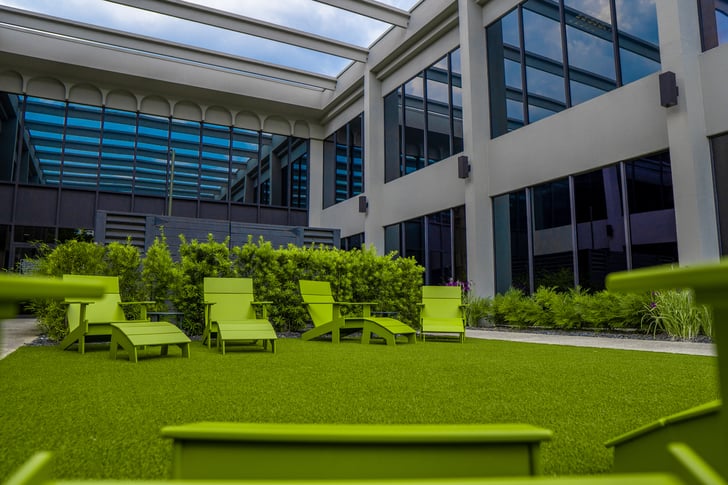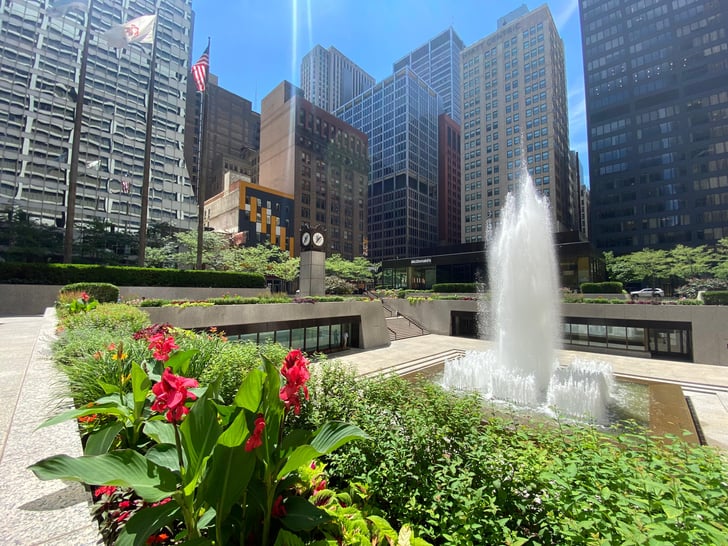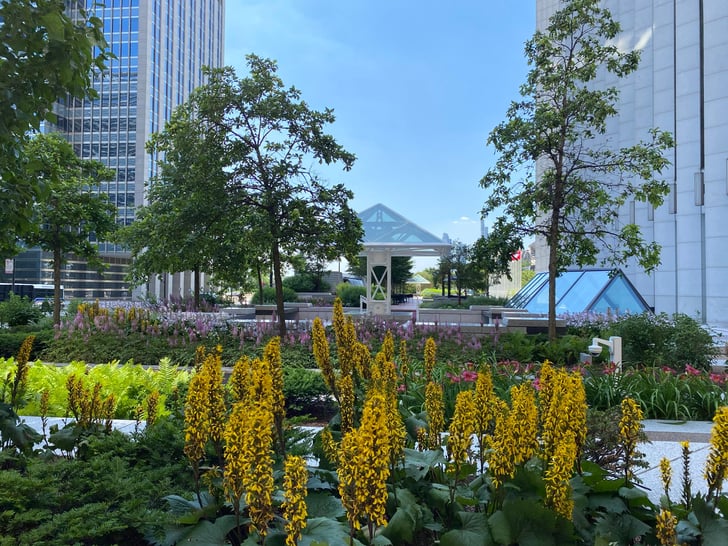There are so many hidden benefits of well-kept landscapes in commercial settings, and April is the ideal time to reveal them, as it is National Lawn Care Month. Urban areas and downtown properties can play a huge role in promoting the value of green spaces, along with setting impressive examples for all property owners.
In this article, we’ll be discussing the economic benefits that follow when outdoor commercial spaces are designed with beauty, functionality, and sustainability in mind. However, the most significant benefits might be found in the elevated human experience created when green spaces connect the dots of well-being (a couple of these were news even to us).
The Science of Lawns and Their Benefits
To see the upside that enhanced landscaping brings to urban areas, the best place to begin is ground zero—the lawn. Gone are the days of turf care that failed to follow a natural path. Today, the most attractive commercial lawns are a result of responsible turf programs that allow nature to work its wonders with some steering from turf professionals who care about the environment as much as they care about healthy lawns.
This natural path is a positive loop that benefits all of us. For one, flourishing turf provides naturally cooler spots for people to lounge outside in downtown areas or play catch with the kids at a park. A healthy lawn is often up to 25 degrees cooler than sidewalks and other hard surfaces.
Additionally, turfgrass is a terrific filter for stormwater, with studies showing well-kept lawns can improve water quality. It may be hard to believe, but it only takes a small section of grass to provide enough oxygen to sustain several human beings—with cleaner air as a bonus! This is crucial, with air pollution now identified as one of the world’s leading environmental health threats.

Natural Noise Reduction
Most people agree that one of the things that makes suburban areas more peaceful than cities is the reduced congestion and noise.
But urban areas have many opportunities to mitigate this aggravation and enhance the quality of life using landscaping strategies. Three options for reducing noise and protecting residents’ hearing are:
- Berms (shown to reduce noise levels by 10–15 decibels)
- Dense shrubs
- Leyland cypress trees
Green walls and green roof systems are also natural noise shields (we’ve included some green roof case studies just below).
Responsible property owners understand that protecting hearing is essential due to possible side effects of hearing loss that lead to heavier losses, including:
- Linked to increased risk of dementia (even mild hearing loss)
- Social withdrawal
- Anxiety and depression
- Balance issues and increased risk of falls
Energy Savings Evidence
No property owner or manager enjoys receiving hefty utility bills. And these costs keep rising, too. So, it’s no wonder most property owners are looking closer at the energy savings that forward-thinking landscape principles and designs offer.
A healthy lawn offers an escape for people surrounded by hot asphalt, and the turf has a cooling effect on nearby structures. The more grass, the more pronounced the cooling. When you add trees to commercial landscaping designs, the additional shade scientifically beats the heat, helping avoid extreme heat that we know to be a severe health hazard (not just heat exhaustion but taking a life-long toll).
Properties investing in turf and trees is like money in the bank as it increases curb appeal and property values while saving on utility bills. Reports show a reduced need for air conditioning in the summer due to turf’s cooling properties. Also, heating costs have been shown to drop due to trees and shrubs acting as organic insulators from frigid winter temps.
Cooling Effects
Everyone appreciates the leisure opportunities provided by parks blessed with ample shade. However, few people understand how critical access to cool, comfortable climates is with regional weather patterns evolving. While “food deserts” (urban areas that lack access to stores offering fresh fruits and vegetables) have received increased press coverage, “shade deserts” have yet to garner the same level of attention.
However, researchers are moving the needle on the lack of awareness. The UCLA Luskin Center for Innovation found that heat health is a significant concern in much of the country, especially in low-income, urban areas. By shining a light on this heat-equity problem, all of us can take a preventive approach to improving the health of people living in urban areas lacking beneficial shade.
The old Greek saying about planting trees where you yourself will never enjoy the shade has never been more relevant. Luckily, there are some low-cost solutions for increasing shade:
- Planting native trees that thrive in their natural environment
- Proper commercial tree trimming to prevent disease and extend lifespan
- Durable, low-maintenance outdoor shade structures
The Downtown Landscaping Challenge
Adding grass and plants matters in all locations but even more so in urban areas.
Plants and vegetation provide natural cooling through transpiration and evaporation—critical components of the water cycle where moisture returns to and cools the air. Incredibly, a large tree can transpire up to 100 gallons of water per day!
Man-made materials (concrete, asphalt, steel) disrupt this cooling process, resulting in an “urban heat island effect,” where temps can rise as much as 22°F higher than surrounding rural areas. It’s easy to see how a single large tree positively impacts a downtown park, hotel landscaping, or a business’s outdoor employee area!

Urban Landscaping’s Additional Benefits
Healthy lawns and lively landscape designs achieve more than curb appeal and a lift in property values. Quality green spaces on commercial properties add optics value. Branding doesn’t stop inside the front door. Branding extends to outdoor spaces as well because limitless aesthetic opportunity awaits. Not just with vibrant flowers and unique plants either.
High-quality landscapes are known for attracting customers and encouraging them to extend visits. A visually pleasing environment leads to longer stays and more sales for the business.
Beyond the financial benefits of well-kept downtown landscaping, it’s as crucial to notice green space benefits for employees, residents, guests, and visitors. Studies across various urban settings have highlighted how enhancing green spaces is lowering crime.
One report revealed a 10% drop in overall crime, while in a different city, gun violence fell by roughly 12% after a community clean-up and a commercial landscaping upgrade. In Chicago, you can see patterns emerge on maps, highlighting that higher crime areas lack parks and natural areas, in contrast to areas with ample green spaces and lower crime.
Still, there’s another hidden benefit. Simply put, green spaces are better for children—learning, stress reduction, and feeling comfortable and safe. This is a crucial aspect of reducing crime, not just today, but tomorrow, because even the most cynical individual would agree that hope lives in every child.
Just as impressive as decreasing crime, the individual health benefits of thriving lawns and landscaping elements. The following are a few examples:
- Lowered heart rates
- Increase in physical exercise
- More productive employees
- Better hospital patient outcomes
Urban Landscaping’s Additional Benefits
Hopefully, we’ve made a solid case that commercial landscaping should be an integral part of any municipal or business strategy. Decreased energy usage will save money over the coming years with utility prices expected to rise. Then there are boundless savings from avoiding crime-related problems. Plus, it makes sense that revenues would increase when people feel safe and secure where they shop, live, and travel.
Don’t forget the positive impacts leading to happier, healthier employees which can improve retention rates. Also, there are children and less fortunate individuals depending on all of us to provide environments that elevate their experience. What better way to achieve this than by creating healthy lawns and appealing landscape designs?
Contact us so we can help you with ideas for upgrading your space’s landscaping, whether urban or suburban.
*Sources and bonus resources:
Lawrence Berkeley National Laboratory Study
GSA Green Roof Benefits and Challenges Study



